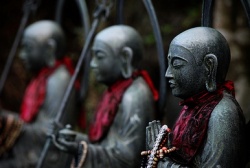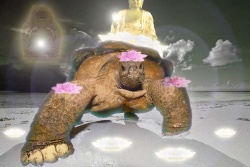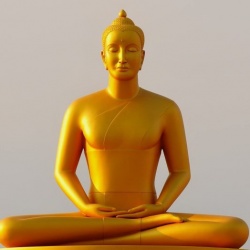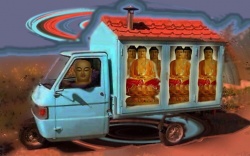Geshe Ngawang Dhargyey
Geshe Ngawang Dhargyey (1925 – 1995) was noted primarily as a masterful Buddhist teacher. Educated at Sera Je Monastery, he trained nine incarnate lamas (tulkus) and thousands of Westerners. Appointed by the Dalai Lama as the first teacher for Westerners at the Library of Tibetan Works & Archives in Dharamsala, he taught there for 13 years. After an extensive international teaching tour, he founded the Dhargyey Buddhist Centre in Dunedin, New Zealand, and taught there for the rest of his life.
My Memories of Geshe Ngawang Dhargyey
Dr. Alexander Berzin
I first met and started studying with Geshe Ngwang Dhargyey in 1970 in Dalhousie, India. I had arrived in India the year before on a Fulbright Fellowship to do the research for my PhD dissertation. I had already connected with Geshe Wangyal in New Jersey while learning Tibetan at Harvard and, once in India, I had turned to help from Sharpa and Khamlung Rinpoches, two young reincarnate lamas (tulkus) who had studied English in America under Geshe Wangyal’s guidance.
After realizing that writing about the Guhyasamaja Tantra for my thesis was far above my head, His Holiness the Dalai Lama’s Junior Tutor, Kyabje Trijang Rinpoche, advised that I study lam-rim, the graded stages to enlightenment, instead. Geshe Ngawang Dhargyey was Sharpa and Khamlung Rinpoches’ teacher and they asked him on my behalf if he would agree to teach me lam-rim and he kindly consented. I was his first Western student.
Geshe Dhargyey lived in an abandoned mud and dung cowshed, in a room big enough just for his bed and a tiny space along its side for his students to sit on the floor. His toothless, ever-cheerful cook, Khedup Tarchin, stayed in the even tinier kitchen space. Gen Rinpoche, “Precious Elder” as we called him, was famous as a teacher of young tulkus – nine were under his care – and renowned as a learned debater and practitioner. So I was confident that he was more than qualified.
My lessons were six days a week. Sharpa and Khamlung translated for me, since Gen Rinpoche spoke with a heavy Khampa dialect that was almost unintelligible to me at that time. Another young tulku, Jhado Rinpoche, also sat in on my lessons. He went on to become abbot of the Dalai Lama’s Namgyal Monastery and is presently the abbot of Gyuto Tantric Monastery. We all squeezed into the tiny space on the side of Gen Rinpoche’s bed.
The hut itself seemed always teeming with flies. That didn’t seem to bother anyone in the room except me. Khamlung Rinpoche would in fact play fly games, by catching them in his hand – he was incredibly skilled at that – shaking them up and then releasing them. They would dizzily fly away and they would all laugh. I was not particularly amused. Seeing my discomfort, one day Gen Rinpoche stood up on his bed and waved his robe wildly in the air to chase the flies away, and then looked at me and laughed. After that, I focused more on our lessons and learned to ignore the flies.
After a while, I gave Gen Rinpoche some money to move into a better place to live. He kindly accepted, but loving to be mysterious and to play jokes, he wouldn’t tell any of us where he moved to. He just disappeared and waited for us to find him. When we did, he roared with laughter. He had moved into a tin hut next to Gyume Tantric Monastery – a great improvement. We continued my lessons there and, from time to time, together with the young tulkus, we went for long walks and picnics in the beautiful mountain meadows. Gen Rinpoche always loved picnics.
His Holiness the Dalai Lama knew of our lessons and started to give us some small Tibetan texts to translate into English for publication. Then, in 1971, His Holiness had the Library of Tibetan Works & Archives built in Dharamsala. We were all in Dharamsala that autumn attending some Guhyasamaja teachings His Holiness was giving, when His Holiness asked Gen Rinpoche to be the teacher for Westerners at the Library, and Sharpa and Khamlung Rinpoches to be the translators. I asked if I could also be of help, and His Holiness agreed, but recommended I go back to Harvard first, hand in my thesis, get the doctorate degree and then come back. I did that and returned the next year, joining Gen Rinpoche and the two tulkus in Dharamsala. Together, we founded the Translation Bureau at the Library.
For the next twelve years, except for an extensive international teaching tour, Gen Rinpoche taught six days a week at the Library. I attended almost all of his classes and took extensive notes on everything he taught. At that time, it was possible for Commonwealth citizens to stay in India without a visa, and so many of the students were able to live in Dharamsala for years on end. This enabled Gen Rinpoche to teach several year-long courses on many of the major Buddhist treatises and to guide us in ongoing meditation instruction. He also gave tantric initiations and extensive teachings on the practices. Every few weeks, we would gather with him to do the Guru Puja, which he taught us how to do. This was an incredible time: we were so fortunate to have this unique opportunity.
What was especially memorable was how enthusiastic Gen Rinpoche was whenever he taught, and how he always blended profound explanations with earthy humor. He never tired of explaining the same things over and again when we didn’t remember what he had taught – an inspiring example of compassion and patience. He also was extremely meticulous about discipline and his monk’s vows. Even if he got up in the middle of the night to go to the toilet, he would put on his monastic shawl.
Gen Rinpoche helped me through many difficult periods. When Tzenzhab Serkong Rinpoche died so suddenly in Spiti, I went to Gen Rinpoche’s rooms right after I heard. Serkong Rinpoche was also one of Gen Rinpoche’s teachers. I walked in and found Gen Rinpoche sitting with some Tibetan friends drinking tea and happily chatting. He told me to sit down and wait until they left. When they did and I told him I had just heard of Serkong Rinpoche’s dying, he told me he also had heard. He then proceeded to count on his rosary every one of his teachers who had also died already. He said death comes to everyone: that’s not surprising. But if we’ve been keeping our teachers and their advice in our hearts, then no matter if they bodily pass away, they are always with us. And life goes on. This helped me enormously.
Gen Rinpoche left the Library in 1984, accepting an invitation to settle and teach in Dunedin, New Zealand. It seemed fitting that he would move to such a remote place, so distant from Europe and North America. He always liked to be bit mysterious and make students put in effort to find him and receive his teachings.
Gen Rinpoche stayed in New Zealand until he passed away in 1995. Because of diabetes he had lost his sight, but continued teaching and doing all his daily practices by heart up to the end.
I only met Gen Rinpoche two more times after his move to New Zealand. But I am eternally grateful for his grounding me in all the basic Buddhist teachings and practices, and for teaching me the great Indian and Tibetan treatises. His reincarnation, Yangsi Rinpoche, was born in 1996 and is currently pursuing his education at Sera Je Monastery in South India.



